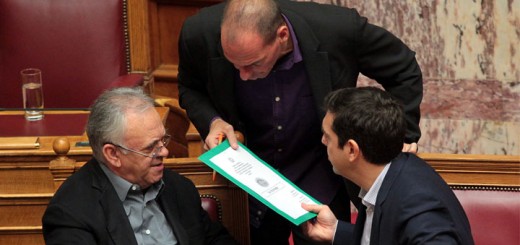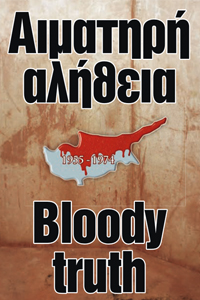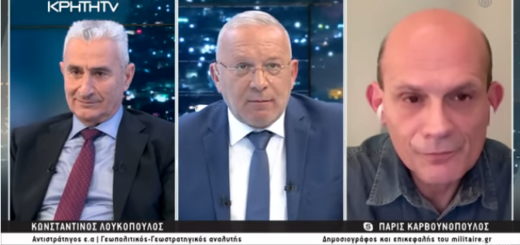Όλο το σχέδιο »EURECA» για την Ελλάδα
(άρθρο του 2011)
ΟΛΟΚΛΗΡΟ ΤΟ ΣΧΕΔΙΟ ΣΤΟ ΤΕΛΟΣ ΤΟΥ ΑΡΘΡΟΥ.
Την εκχώρηση των περιουσιακών στοιχείων του δημοσίου σε μια εταιρία, με έδρα το Λουξεμβούργο και την σταδιακή πώλησή τους με στόχο τη μείωση του χρέους στο 88% του ΑΕΠ περιλαμβάνει μυστικό «plan B» της Γερμανίας για τη διάσωση της Ελλαδας με την κωδική ονομασία «Εureca».
Σύμφωνα με το σχέδιο, το οποίο επεξεργάζονται -σύμφωνα με την γαλλική La Tribune- οι στενοί σύμβουλοι της γερμανίδας καγκελάριου Α. Μέρκελ με επικεφαλής τον Martin Wittig, διευθύνοντα σύμβουλο της εταιρίας Roland Berger, η Ελλάδα θα πρέπει να εκχωρήσει περιουσιακά στοιχεία αξίας 125 δισ. ευρώ, σε μια εταιρία holding με έδρα το Λουξεμβούργο.
Στα περιουσιακά στοιχεία περιλαμβάνονται τράπεζες, ακίνητα, λιμάνια, τηλεπικοινωνίες ενώ η διαδικασία ιδιωτικοποίησης εκτιμάται ότι θα έχει ολοκληρωθεί έως το 2025.
Το σχέδιο κάνει λόγο για εξαγορά της εταιρίας holding από την Ευρωπαϊκή Ένωση, έναντι 125 δισ. ευρώ.
Η Ελλάδα θα χρησιμοποιήσει τα 125 δισ. ευρώ για να αποπληρώσει μέρος των υποχρεώσεων προς την ΕΚΤ και το EFSF, μειώνοντας έται το χρέος της στο 88% του ΑΕΠ από σημερινά επίπεδα στο 145%, χωρίς να απαιτηθεί «κούρεμα».
Με τη μείωση του χρέους η Ελλάδα θα μπορέσει να επιστρέψει στις αγορές ενώ αναμένεται να επανακτήσει επενδυτική αξιολόγηση (Α ή Α+) βραχυπρόθεσμα, σημειώνεται σχετικά.
Η εταιρία με έδρα το Λουξεμβούργο θα έχει τη δυνατότητα να επενδύσει 20 δισ. ευρώ στην αναδιάρθρωση των ελληνικών στοιχείων ενεργητικού, ώστε να μεγιστοποιηθούν τα έσοδα από τις ιδιωτικοποιήσεις. Η Roland Berger εκτιμα ότι αυτό θα αποφέρει άμεσα περί τα 40-60 δισ. ευρώ.
Τα προγράμματα αναδιάρθρωσης θα έχουν θετική επίδραση 8% του ΑΕΠ στην ελληνική οικονομία, κάτι που θα επαναφέρει την Ελλάδα σε θετικούς ρυθμούς ανάπτυξης της τάξεως του 5%, ενώ ταυτόχρονα θα οδηγήσει σε αύξηση των φορολογικών εσόδων ύψους 4% του ΑΕΠ.
Παράλληλα, θα μειωθεί περισσότερο από 50% το βάρος των επιτοκίων δανεισμού της Ελλάδας, χάρη στη μείωση του χρέους και τη βελτίωση της πιστοληπτικής αξιολόγησης.
Όλα τα ανωτέρω θα δώσουν στην Ελλάδα τη δυνατότητα να επαναγοράζει χρέος ύψους 1% του ΑΕΠ ετησίως, κάτι που θα οδηγήσει το δημόσιο χρέος σε επίπεδα κάτω του 60% έως το 2018, εκπληρώνοντας έτσι τα κριτήρια της Συνθήκης του Μάαστριχτ.
Οι ιδιωτικοποιήσεις θα έχουν ολοκληρωθεί έως το 2025 και, σε περίπτωση που υπάρξει υπεραξία, θα αποδοθεί στην Ελλάδα αφαιρουμένων των τόκων. Αν τα έσοδα είναι χαμηλότερα των 125 δισ. ευρώ, η Ελλάδα θα αναλάβει το κόστος, υπό την προϋπόθεση ότι το συνολικό ποσόν δεν υπερβαίνει το 30% του ΑΕΠ ή τα 150 δισ. ευρώ έως το 2025. Οι αναλυτές της Roland Berger εκτιμούν ότι και σε αυτή την περίπτωση, το χρέος θα υποχωρήσει κάτω του 70% του ΑΕΠ.
Ο σχεδιασμός αυτός θα αποθαρρύνει τους κερδοσκόπους που ποντάρουν σε χρεοκοπίες των χωρών της ευρωπαϊκής περιφέρειας μέσω των CDS, οδηγώντας σε κατάρρευση των spreads των αδύναμων κρίκων της Ε.Ε.
Ταυτόχρονα, η ιδιωτικοποίηση κατά 100% του δημόσιου τομέα στην Ελλάδα θα οδηγήσει και σε εξάλειψη της διαφθοράς, ενθαρρύνοντας έτσι την μακροπρόθεσμη ανάπτυξη και τις επενδύσεις.
Μια ακόμη θετική επίπτωση του σχεδίου είναι ότι η αξία των ελληνικών ομολόγων που έχουν στα χέρια τους οι ελληνικές τράπεζες θα αυξηθεί κατά 30 δισ. ευρώ, αποκαθιστώντας τη φερεγγυότητα του τραπεζικού συστήματος και μειώνοντας το ρίσκο ενεχύρων της ΕΚΤ κατά 95%, θέτοντας τέρμα στην κρίση ρευστότητας της Ελλάδας.
ΟΛΟΚΛΗΡΟ ΤΟ ΣΧΕΔΙΟ (EΛΛΗΝΙΚΑ – ΑΓΓΛΙΚΑ)
1η Φάση: Η Ελλάδα θα συγκεντρώσει όλα τα περιουσιακά στοιχεία της (τράπεζες, ακίνητα, λιμάνια, τηλεπικοινωνίες κλπ) σε έναν φορέα παρόμοιο με την Treuhandastalt η οποία δημιουργήθηκε το 1990 στη Γερμανία για να προωθήσει την ιδιωτικοποίηση περίπου 8.500 εταιρειών της πρώην Ανατολικής Γερμανίας. Η αξία αυτών των περιουσιακών στοιχείων υπολογίζεται στα 125 δισ. ευρώ, με βάση τις εκτιμήσεις που έχουν γίνει για ορισμένα από αυτά που περιλαμβάνονται στην «επίσημη» λίστα των προς ιδιωτικοποίηση εταιρειών.
2η Φάση: Ο συγκεκριμένος φορέας στη συνέχεια θα εξαγοραστεί από ένα ευρωπαϊκό όργανο που θα χρηματοδοτείται από τις χώρες-μέλη της ΕΕ και θα μπορούσε να έχει την έδρα του στο Λουξεμβούργο. Το όργανο αυτό θα αναλάβει να προωθήσει τις ιδιωτικοποιήσεις και να ολοκληρώσει το έργο του μέχρι το 2025.
3η Φάση: Τα 125 δισ. ευρώ που θα «απελευθερωθούν» με τον τρόπο αυτό, θα χρησιμοποιηθούν από την Ελλάδα για την εξαγορά των υποχρεώσεών της προς την Ευρωπαϊκή Κεντρική Τράπεζα και το Ευρωπαϊκό Ταμείο Χρηματοπιστωτικής Σταθερότητας. Το άμεσο αποτέλεσμα θα ήταν να μειωθεί το χρέος στο 88% του ΑΕΠ, από 145% που είναι σήμερα. Ταυτόχρονα, η έκθεση της ΕΚΤ στο ελληνικό χρέος θα πέσει στο μηδέν και τα επιτόκια του ελληνικού χρέους θα μειωθούν κατά 50%, επιτρέποντας στην Αθήνα να επιστρέψει στις αγορές.
4η Φάση: Ο ευρωπαϊκός φορέας θα επενδύσει στη συνέχεια 20 δισ. ευρώ για την αναδιάρθρωση των περιουσιακών στοιχείων ώστε να αυξηθεί η αξία τους κατά 50 δισ. ευρώ περίπου. Το ποσό αυτών των επενδύσεων ενδέχεται να αυξηθεί κατά 10 με 15 δισ. από τα διαρθρωτικά ταμεία τα οποία η Ελλάδα δεν μπορεί να χρησιμοποιήσει επί του παρόντος.
5η Φάση: Με αυτήν την «ένεση» στην οικονομία η χώρα θα επιστρέψει στην ανάπτυξη. Υπολογίζεται μάλιστα ότι η ανάπτυξη τα επόμενα τρία ή τέσσερα χρόνια θα μπορούσε να φτάσει το 5%.
6η Φάση: Η Ελλάδα θα ενταχθεί σε ένα πρόγραμμα εξαγοράς του χρέους της, της τάξης του 1% του ΑΕΠ κατ’ έτος, έτσι που μέχρι το 2018 το δημόσιο χρέος θα πέσει κάτω από το 60% του ΑΕΠ.
EURECAproject Hellenic Recovery Fund –a solution for Greece and Europe
Frankfurt, September 2011
•The Greek solvency crisis –in combination with speculative attacks on several euro zone countries –has placed a tremendous strain onfiscal and monetary policy in Europe
•It will not be possible to protect the integrity of the euro zone without austerity (substantial savings in the affected countries), solidarity(a willingness to share the burden) and creativity(understanding the workings of the capital market and playing the game by the corresponding rules)
•The current conundrum for European policymakers does not seem to have a «mathematical solution space» –In real fiscal terms, it has so far only aggravated the problems for all concerned
•Yet we believe that resolving this conundrum is vital if the EU is to return to a pattern of ongoing economic integration and progress
•This document describes the foundation on which such a solution can be built Bundle Greek state assets worth EUR 125 bn in a central trustee organization (holding company)
2.Sell entire holding company to European Union for EUR 125 bn
3.Allow Greek state to use proceeds to repurchase bonds from ECB and EFSF
4.In so doing, reduce Greek debt from 145% to 88% of GDP
5.Reduce ECB’s and taxpayers’ exposure to Greek debt to zero
6.Invest EUR 20 bn in restructuring assets to maximize value of privatization (plus EUR 40-60 bn)
7.Add 8% GDP stimulus to Greek economy as side-effect of restructuring program
8.Drive growth swing from -5% to +5%, producing additional tax revenue equivalent to 4% of GDP
9.Cut interest burden by more than 50% thanks to debt reduction and rating improvements
10.Combine (8) and (9) to enable debt repayment worth 1% of GDP p.a., leading to a debt ratio that is clearly within the 60% debt ceiling of the Maastricht criteria.
11.Payout of any surplus to Greece in 2025 to fund additional debt reduction –Any shortfall should be covered by Greece provided the required sum does not exceed 30% of GDP (i.e. no more than EUR 150 bn by 2025/26)
12.Side-effect 1: CDS spreads will collapse, causing speculators to incur losses and preventing attacks on Ireland, Portugal and Spain
13.Side-effect 2: 100% privatization of Greek public sector will stamp out corruption and foster long-term growth and investment
14.Side-effect 3: Greek banks holding Greek bonds will see value gain of EUR 30 bn, restoring solvency of banking system and reducing collateral risk for ECB by 95%, thereby ending Greece’s credit supply crisis
15.Safe non-default repurchasing option on Greek bonds could also be implemented as an option
•This paper outlines actions to solve the Greek debt crisis and protect the integrity of the euro
•It is designed to achieve the following goals:
In the short term
Reduce Greek debt from 145% to 88% of GDP in one step, without debt restructuring
Allow Greece to regain investment grade rating (A or A+) in the short term
Reduce interest burden by reducing CDS spreads from currently over 20% to less than 5% virtually overnight
Reduce ECB exposure to Greek sovereign debt to zero
Ensure maximum risk containment and risk reduction for the European taxpayer
Credibly repel speculation against both the euro and the peripheral euro member countries
In the medium and long term
Prevent the value destruction that would be triggered by a «fire sale» privatization
Support structural reform with a view to long-term growth in Greece
Kick-start the Greek economy and revive growth and job creation
Enable Greece to begin taking steps that will ultimately reduce its debt to significantly below 60% of GDP by 2025
•Market’s judgment of Greek debt sees the country firmly locked in a debt trap –Probability seen by the markets that Greece will NOT default over the next five years is close to zero based on current CDS spreads
•Current debt restructuring efforts have had the advantage of putting very considerable pressure on Greek politics to initiate structural adjustments. However, the marginal impact on political action in the country is waning as frustration about the ratio of effort to return begins to affect market sentiment
•»Fire sale» privatization is not an option, as such a process would further depress the value of assets
•Nor is gradualprivatization a realistic option, as the staggered impact of resultant revenue would be swallowed up by the ever-growing interest burden on debts that continue to grow in the meantime
•Solution: Create a European asset purchase and privatization vehicle combined with a conditional residual guarantee to drive down funding costs:
–Bundle Greek state assets in one or several privatization holding companies established as European SEs
–Group assets into participating interests (banks, industry, utilities, etc.), real estate, etc.
–Trigger wholesale purchase of SEs by a European facility (potentially under the EFSF program) for a sum of EUR 125 bn and repurchase Greek bonds held by ECB and other European institutions and states
–Manage privatization program by EU institution with private cooperation partners (public-private partnership) to leverage best practices in restructuring, asset management and placement
–Avoid fixed sales closure dates to reduce market pressure from vulture funds
•Solution (contd.):
–Set up a EUR 20 bninvestment program to optimize asset values and thus maximize sales revenue (asset restructuring) –Use money from the European Structural Funds to some extent
–This will simultaneously provide additional demand stimulus to the Greek economy and improve both the tax base and the debt/GDP ratio
–Introduce a structural debt reduction program of 1% of GDP per year to further reduce Greek public debt to below 60% of GDP by 2025 (and possibly under 40% if the 1% of GDP per year repayment rule is strictly applied)
–Target closure of the transaction in 2025, including a surplus/shortfall sharing feature
If privatization yields a surplus after initial investment plus the interest burden on funding costs, the proceeds should be transferred to Greece to fund further debt repayment
If the transaction yields a shortfall, remaining assets should be repurchased by Greek state at the discounted amount but with a cap of 30% of Greek GDP. The resultant total debt burden should likewise be limited to 75% of GDP.
Structural repayment program should in this case be continued through 2040 to comply with Maastricht criteria
This transaction would effectively repel speculation targeted at other European Union member states as well, since speculative investors (who do not trust European governments and institutions to come up with a creative solution or have the strength to toe the line) would suffer severe losses triggered by falling CDS spreads
Euro2Day
»Τhe New Daily Mail»
Newsroom
Πηγή: Τhe New Daily Mail
Το είδαμε: ΑΒΕΡΩΦ Διαδικτυακό Θωρηκτό
EURECA project Hellenic Recovery Fund – a solution for Greece and EuropeRolandBerger Strategy Consultans(αρχείο σε μορφή .pdf)

































